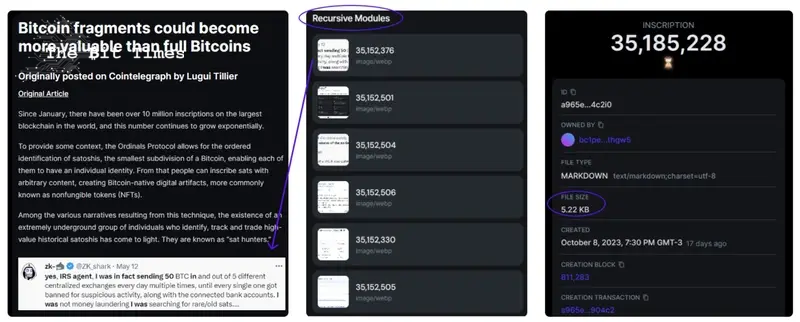Bitcoin is evolving into a multi-asset network
For more than a decade, the primary narratives surrounding Bitcoin (BTC) have focused on its role as a peer-to-peer digital cash and store of value.
However, all indications suggest that we are witnessing a significant shift in this paradigm.
Since the beginning of 2023, one of the most discussed topics in the Bitcoin ecosystem has been the use of the world's leading blockchain to store information that goes beyond the previously mentioned use cases.
Related: Bitcoin fragments could become more valuable than full Bitcoins
If you have been isolated in an igloo during this crypto winter and are unaware of the developments, here is a brief overview.
In January 2023, developer Casey Rodamor introduced Ordinals to the world, a protocol that allows you to permanently inscribe any file into the Bitcoin blockchain.
This wasn't the first method created for such an action, but it gained the most traction, creating a trend where nonfungible token (NFT) collections, music, video games, journalistic articles, and even WikiLeaks records began to be stored in an eternal and immutable manner on the world's largest decentralized network.
'Anonymous activist group is inscribing the Afghan war logs published by WikiLeaks into #Bitcoin to protest imprisonment of Julian Assange' @BitcoinMagazine #FreeAssange https://t.co/1huZ6J9SDM
— WikiLeaks (@wikileaks) October 23, 2023
As a result, experiments, innovation, and the perspective of the Bitcoin network as a vast decentralized database began to simmer.
Despite being less than a year old, the Ordinals protocol has been evolving remarkably to become more efficient and to enable bolder use cases.
One of the noteworthy enhancements is the technique of recursive inscriptions, which allows users to circumvent the 4-megabyte storage limit per block, enabling the insertion of larger data on the Bitcoin blockchain.
As an example — illustrated by the image below — I inscribed an entire article from Cointelegraph on Bitcoin using a recursive inscription.

In total, eight inscriptions were made to achieve the final result, at a total file size of 5.22 kilobytes. (That’s small.) Seven of the inscriptions were images from the article, each stored individually in a Satoshi through the Ordinals protocol. The eighth inscription comprises a code that contains the article's text and issues requests to retrieve the images from the other Satoshis.
Related: Bitcoin has entered a civil war — Over ‘art’
This assembly allowed for the complete article to be eternally inscribed on the Bitcoin blockchain, a feat that couldn't have been achieved in a single step while maintaining quality.
Leonidas, a developer within the Ordinals community, offered an even more profound perspective on the matter on Twitter, writing:
What if lots of people upload lots of packages of code into the Bitcoin Blockchain? So now there is a huge repository of packages for developers to build on top of. This would unlock powerful use cases that could never be accommodated in under 4 MB. The most complex pieces of software are just a bunch of code compiled together after all. Now it becomes possible to put a complex 3D video game fully on-chain on Bitcoin.
Complex 3D video game fully on-chain on Bitcoin.The sky is the limit. Bitcoin is essentially getting an internal internet where every file can request data from the other files on Bitcoin. Its unclear yet exactly how people will use this but it is undoubtedly an important moment
— gaww.btc (@gawwbtc) June 17, 2023
With just this, a world of possibilities can be contemplated and reimagined. After all, the ability to use the world's leading blockchain as an immutable, shared, and uncensored data storage is huge.
But the innovations don't stop there!
In October, Lightning Labs announced the first mainnet release of Taproot Assets (TARO), further enhancing the Bitcoin blockchain as a multi-asset network.
Announcing the first mainnet release of Taproot Assets , a protocol for assets on #bitcoin and Lightning.
— Lightning Labs️ (@lightning) October 18, 2023
With this release, developers can issue financial assets on-chain in a scalable manner.
Today marks a new era of multi-asset bitcoin. https://t.co/2cNvZSvv8v
This could not have occurred at a more opportune time, given the enthusiasm ignited by the Ordinals protocol and the way it paved the path for TARO to shine alongside it.
The Ordinals Protocol has broadened the perspective of users and builders, allowing them to construct and view Bitcoin as a network of multiple assets.
Ordinals assets — via flooding the network with transactions — compelled Binance to implement an integration with Lightning. This key factor, combined with low costs, decentralization, and high network settlement speed, makes trading other coins and assets very attractive through Taproot Assets.
And among the various applications of the TARO protocol, one of the most mentioned is the ability to issue stablecoins on the Bitcoin blockchain.
The shift in paradigm is monumental as it paves the way for Bitcoin to transform from being primarily an exchangeable asset to becoming the medium through which exchanges occur.
This innovation is going to empower builders to import successful use cases from other chains and bring them back to the mothership.
Some even joke that all other chains are just Bitcoin's test nets. Does it all lead back to Bitcoin?
THE BITCOIN RENAISSANCE CAN’T BE STOPPED
— Udi Wertheimer (@udiWertheimer) May 16, 2023
the magicians at @lightning labs are back with an efficient protocol for tokens on top of bitcoin
ethereum was a testnet. get in anon we’re going to the moon pic.twitter.com/2g6vPFBAbV
Overall, we could say that we are on the edge of a new Bitcoin era — the era of the multi-asset orange network.
In addition to attracting and retaining more developers who may be interested in these new protocols, these new applications also have the potential to draw in and retain new users who initially didn't find interest or value in Bitcoin as a store of value.
For some, transforming the world can sometimes occur through the simple enjoyment of some fun, encrypted sports cards. But with the optimization of Ordinals, the number of possibilities will continue expanding.

Hal Finney, a prominent cypherpunk — and the first person to receive a transaction from Bitcoin creator Satoshi Nakamoto — wrote in a 1993 post on Compuserve: “Giving a little more thought to the idea of buying and selling digital cash, I thought of a way to present it. We’re buying and selling cryptographic trading cards.”
Finney knew, and now you know too.
This article is for general information purposes and is not intended to be and should not be taken as legal or investment advice. The views, thoughts and opinions expressed here are the author’s alone and do not necessarily reflect or represent the views and opinions of Cointelegraph.
Comments
Post a Comment